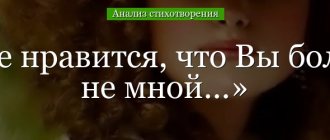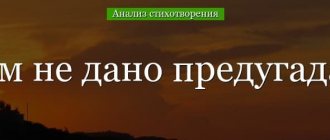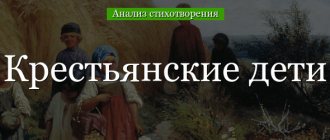Genre, direction, size
Mayakovsky’s poem was written in 1912, at that time the poet was not yet absorbed in the problem of the revolution, so the work contains the theme of loneliness, city bustle, and misunderstanding. The author openly opposes the norms of the Russian language, against classical epithets and metaphors. All this allows us to determine the direction of the poem - futurism. Unusual images, wordplay, and linguistic experiments demonstrate the poet’s desire to protest the previous laws of versification. However, the work belongs to early lyric poetry, so there is a division into stanzas and rhyme.
The poem is written in dactyl, consists of three quatrains, cross rhyme.
History of creation
One of Mayakovsky’s famous futuristic works is the poem “Night,” written in 1912. In essence, it was a response to the manifesto of the Italian futurists. Mayakovsky partly disagreed with their ideological positions, since he considered the “telegraph style” in the lyrics too extravagant. The poet advocated innovations in poetry, but saw them in a different form and presentation than the Italians. Although...Vladimir was an ardent admirer of the work of F. T. Marinetti and even came to his performances in Russia. He borrowed the “ladder” from the famous discoverer of futurism, but he didn’t just “make it”, but brought the already well-known method to perfection. The diamond was not made by a jeweler, but the diamond is the creation of human hands. In a word, for Mayakovsky this manifesto and its author were very important.
This creative period of the poet was not yet influenced by the revolution of 1917, so pessimistic notes were visible in the poems. So in the work “Night” the city appeared before the reader in precisely these colors: dark, rough and deceitful.
Images and symbols
Each paragraph is filled with images that reveal a specific topic. In the first quatrain, the lyrical hero speaks about the onset of night: “and burning yellow cards were distributed to the black palms that came running together at the windows.” But unlike his predecessors, Mayakovsky sees in the night not something mysterious, mystical, but only the embodiment of lust and debauchery. The first two lines create the image of a gambling house: “green” symbolizes the playing board. Mayakovsky touches on the topic of society, raises eternal questions (life is a game).
The second stanza depicts an impersonal crowd. The hero does not see people, in front of him there are only soulless “boulevards and squares.” They all live by the same rules, so any deviation in this society will look strange. The lyrical hero feels lonely in such an environment. The expression “they wrapped their legs with bracelets” symbolizes the lack of freedom of his actions, isolation.
The third stanza is also dedicated to the crowd. The lyrical hero calls society a “motley-haired fast cat.” In his opinion, ordinary people have no need for spiritual development, they only crave entertainment. This crowd can be compared to people who come to Mayakovsky’s own performances. “Drawn by doors,” they go for fun, and not for the sake of comprehending beauty.
The last stanza begins with the pronoun “I”. The lyrical hero draws all attention to himself: the “calling paws” of the crowd force him to “squeeze through” an insincere smile. He is alone in this world of lies and pretense. The image of the crowd is compared to a merciless, wild beast. The hero cannot find anything in common with the world around him; misunderstanding reigns around him (“the araps laughed”).
Mayakovsky Night analysis of the poem
3
(2)
Poem "Night" by Mayakovsky. Analysis.
A conversation about early Mayakovsky’s lyrics usually begins with the poem “Night,” the same one that the poet wrote about in his biography as his “first professional.” What is “The Crimson and the White...” about?
It is difficult for the average person with a primitive, non-artistic way of thinking to understand the poet, and often “absurd” causes nothing but irritation, although in general the beginning of the poem is quite clear. The colors of the day fade, recede into the background. Green twilight sky, stars are lighting up, “blue togas” on the buildings...
But already in the second stanza, an image that is not always clear appears: “And before, for those running, like yellow wounds, / the lights wrapped their legs with bracelets...” What did the poet see here? After all, Mayakovsky is an artist who cannot stand “pretty things,” and he is very precise in every detail depicted.
They talk about his dialogue with David Burliuk about a line from the poem “From Street to Street”: “The magician pulls the rails from the mouth of the tram.” To Burliuk’s remark that the tram should devour the rails, Mayakovsky replied: “David, you’re standing in the wrong place. You stand on the back platform and look!” So how did these “bracelets” on your feet appear?
It is clear that this is light. But where is the source of this light? Neither the moon nor street lamps can “wrap your feet with bracelets” - they provide diffused light, but here there are “bracelets”, a narrow strip of light. This is no longer the case in a modern city, but this is Moscow
1912, Moscow Gilyarovsky! And this light from the basement windows, which only rise above the ground at the very edges, of course, is a trifle and relates rather indirectly to understanding the idea of the poem, but how important and interesting sometimes all sorts of “unimportances” are!
Together with the poet, we walk through the outskirts of Moscow and reach the city center. Fashionable restaurants, expensive shops, joyful, happy, dressed-up audience:
Crowd, motley-haired fast cat,
floated, bending, drawn by the doors;
everyone wanted to drag at least a little
a mass of laughter cast into a coma.
A wonderful image - a cat crowd!
in Mayakovsky, the word is often polysemantic and creates an image at the level of the subconscious, association. The motley crowd is a “motley-haired” cat. But this is only the first layer. Cat - what is it like? Graceful, flexible (that’s why the crowd floats, wriggling), soft, “homely” - and at the same second predatory, aggressive, subordinate to instincts that no one understands.
And now let’s try to imagine an eighteen-year-old boy, poor, ragged, but with a claim to an unappreciated genius, eager for recognition, not averse to shocking behavior; which combines the subconscious fear of being different from everyone else, and then the reluctance to be like everyone else. And all this is superimposed on the desire to love and be loved - at the same time with a boyish complex.
Sometimes it can be interesting to compare with some phenomena of modern youth culture, because in the minds of schoolchildren a gap often arises between the work being studied and the reality surrounding it.
One of Vyacheslav Petkun’s compositions contains the lines: “I’m walking towards colorful shop windows, expensive limousines float by; women rush through them with burning eyes, cold hearts, and golden hair.”
The same “city of a fairy tale, city of a dream” appears before Mayakovsky’s lyrical hero. And if you look at it, two poets write about the same thing. Perhaps the most difficult is the last stanza, and especially its last two lines:
I, feeling the dresses calling paws,
he squeezed a smile into their eyes; frightening
with blows to the tin, the araps laughed,
a parrot's wing blooming above his forehead.
It is this stanza that holds the key to understanding the entire poem. Here is a fleeting glance from a beauty dressed in furs, coming out of a car, accompanied by an overweight rich man, a glance that combines sensual interest and contempt for a ragged beggar, and a response from a poet, combining contempt for “looking like an oyster from the shell of things” with passion, which is akin to anger.
The verb “squeezed through” is interesting, containing some indication of resistance; the poet seems to be making his way into a world alien to him. But this world does not accept the “rude Hun”, and the “butterfly of the poet’s heart” is crushed. What happened to the hero at the end of the poem? What kind of araps are these with a parrot's wing on their forehead, why do they “laugh with blows to the tin”?
Let's return to a kind of video sequence created by the poet. In Moscow's expensive establishments at the beginning of the century, several styles appeared, and among them two were dominant: classical, old Russian, with a gray-bearded gatekeeper wearing medals, and modern, attracting with its unusual, exotic appearance, where the doormen were young Arabs in hats decorated with bright feathers.
The doorman’s task is to “hold and not let go,” to cut off unwanted elements that destroy the illusion of the serenity of life, and the doors to a world shining with lights are slammed in front of a strange young man in a yellow blouse.
The same theme of the conflict between the lyrical hero and the world around him sounds not only in this poem. For example, “They don’t understand anything.” Again the “strange” line: He went to the hairdresser and said calmly:
“Please, comb my ears!” What is this, just shocking behavior from the reading public? Let's try to ask the question: what is a “hairdresser”, what does he do?
Of course, it cuts, makes beautiful, in other words, embellishes, evens out, cutting off curls, unevenness, roughness, levels out, “cuts everyone with the same brush.” “Hairdresser” is a society that puts a person within a certain framework, tight for the lyrical hero, he is not like others, he is unkempt, his ears stick out!
And yet he strives to be understood and accepted by the world, And if this requires “being combed,” he will try! But here is the reaction of society: “The smooth hairdresser immediately became coniferous, / the face stretched out like a pear...” The word “smooth” is very ambiguous in Russian. This includes “smooth”, “unrough”, and “well-fed”, “burly”, “well-fed”, hence the association with pink. (In Bunin’s “Antonov Apples,” the elder’s wife is smooth, like a Kholmogory cow.)
And “coniferous” is clearly the antonym of “smooth”: green, prickly, needle-like, bristling. The world of well-fed and self-satisfied bourgeois does not accept the lyrical hero; in the minds of the average person, he is a jester, a clown, a “redhead.” The “flabby radish” of their heads cannot understand and accept a person who is not like them.
Yes, the futurist poet is seditiously shocking, and so much has already been said about this that it has simply become a commonplace. Many years ago, a certain literature teacher was seriously perplexed in one professional publication about how one could study Mayakovsky at school, who wrote: “I love watching children die.” Of course, in early works there are also lines that are far from the best and even repulsive (like this one), where shocking becomes not only immoral, but simply wild.
And yet, it is necessary to study the early Mayakovsky in order to help see in the poet not only an “agitator, loudmouth, leader,” but also an artist surprisingly close to the modern young man, in whose poems he will see himself.
3 / 5. 2
.
Themes and mood
The poem is imbued with despair, a feeling of hopelessness, and melancholy. The hero realizes that it is impossible to correct these “beasts” that surround him, that he will always be a stranger among the inhabitants. He watches their vulgar, riotous life with contempt.
In the work, the poet discusses themes that were repeatedly reflected in Mayakovsky’s work.
- The poet touches on the topic of society. His lyrical hero sees a corrupt crowd that does not strive for development, but only for entertainment. The night has lost its romantic appearance; for Mayakovsky it symbolizes lust and debauchery.
- Mayakovsky also discusses the topic of loneliness. The lyrical hero feels superfluous in this society of ordinary people and will never be able to find a place for himself in it. He has nowhere to go - the same “masks” will be everywhere.
- The theme of nature is an integral part of Mayakovsky’s work. Many of the futurist's masterpieces contain images of the environment. In this work, he repeatedly refers to nature: “a motley-haired fast cat”, “a parrot’s wing”, “calling paws”. The lyrical hero compares animals with the crowd, showing its savagery. Also, the title of the work itself denotes a natural phenomenon. In this world, everything is inextricably linked with each other, a person is inseparable from the environment.
Means of artistic expression
The use of certain tropes contributed to the creation of a futuristic poem.
- Thus, such a stylistic figure as metaphor plays an important role in the entire work. Mayakovsky avoids direct and understandable expressions, forcing the reader to think for himself. Instead of the word “sunset” the author uses only “crimson”, instead of “playing board” - “green”.
- Mayakovsky also uses a type of metaphor - metonymy. He calls the society "a boulevard and a square." In his opinion, these concepts can be replaced with each other on the basis of similarity. This technique enlivens the city, making it a separate lyrical hero.
- Comparison plays an important role in the text. The poet calls the crowd a “motley-haired fast cat,” pointing to the fickleness of society and the eternal bustle.
- Epithets (“crimson”, “white”, “black”, “yellow”, “blue”) create a real canvas. They enliven the poem and give it dynamism.
Author: Anastasia Smetanova
Interesting? Save it on your wall!




